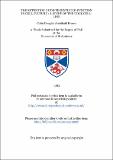Files in this item
The retention of differentiated function in cell culture : a study of the UDCK cell-line
Item metadata
| dc.contributor.advisor | Simmons, N. L. | |
| dc.contributor.author | Brown, Colin Douglas Archibald | |
| dc.coverage.spatial | 123 p. | en_US |
| dc.date.accessioned | 2018-06-12T14:34:04Z | |
| dc.date.available | 2018-06-12T14:34:04Z | |
| dc.date.issued | 1983 | |
| dc.identifier.uri | https://hdl.handle.net/10023/13966 | |
| dc.description.abstract | The transporting properties of MDCK cells have been investigated upon epithelial monolayers grown upon permeable filter supports and mounted in Ussing chambers. When mounted without edge damage epithelial monolayers of MDCK cells (strain I) exhibited a transepithelial electrical resistance of 7.9 kO.cm2 and supported a small open-circuit potential (5.9 mV, basal-lateral surface positive) and a small short circuit current in agreement with the small magnitude of the net Na+, K+ and Cl- fluxes. Addition of adrenaline to the basal-lateral, but not the apical bathing solution stimulated a net basal-lateral to apical Cl- secretion, the magnitude of which accounted for the adrenaline stimulated short circuit current response. The Cl- secretion in MDCK cells exhibited many of the features of Cl- secretion in natural epithelia including sensitivity to the loop diuretics: furosemide, bumetamide and piretanide. In a number of secretory epithelia Cl- is accumulated across the basal-lateral cell border by a diuretic sensitive Na+K+Cl cotransport system. A comparison of the actions of the loop diuretics upon adrenaline stimulated Cl secretion and upon the cotransport system in MDCK cells provided strong but indirect evidence for a central role of the cotransport system in Cl secretion across MDCK cell monolayers. Measurement of influx and efflux across the apical and basal-lateral cell border demonstrated that the apical cell border was relatively impermeable to K. Influx across the basal-lateral border consisted of three major compenents; a ouabain sensitive , pump mediated, component; a diuretic sensitive component and a ouabain and diuretic insensitive flux component. K efflux across the basal-lateral cell border also consisted of these three components. Addition of adrenaline, ATP or A23187 to MDGK cells resulted in a transient stimulation of K+ efflux across both cell borders, although flux across the basal-lateral cell border was of greatest quantitative importance. Stimulation of K efflux was dependent upon the presence of Ca2+ in the external media and exhibited a similar pharmacology; sensitive to quinine and TEA, but insensitive to inhibition by apamin, as Ca2+-dependent K permeability?s in other, natural epithelia. Identification of an adrenaline stimulated Cl- secretory mechanism, a coupled Na + K + Cl cotransport system and a Ca2+-dependent K permeability in high resistance MDCK cells supports their use a model epithelium for the study of epithelial cell function. | en_US |
| dc.language.iso | en | en_US |
| dc.publisher | University of St Andrews | |
| dc.subject.lcc | QH601.B8 | en |
| dc.subject.lcsh | Membranes (Biology) | en |
| dc.title | The retention of differentiated function in cell culture : a study of the UDCK cell-line | en_US |
| dc.type | Thesis | en_US |
| dc.contributor.sponsor | Maitland Ramsay studentship fund | en_US |
| dc.type.qualificationlevel | Doctoral | en_US |
| dc.type.qualificationname | PhD Doctor of Philosophy | en_US |
| dc.publisher.institution | The University of St Andrews | en_US |
This item appears in the following Collection(s)
Items in the St Andrews Research Repository are protected by copyright, with all rights reserved, unless otherwise indicated.

